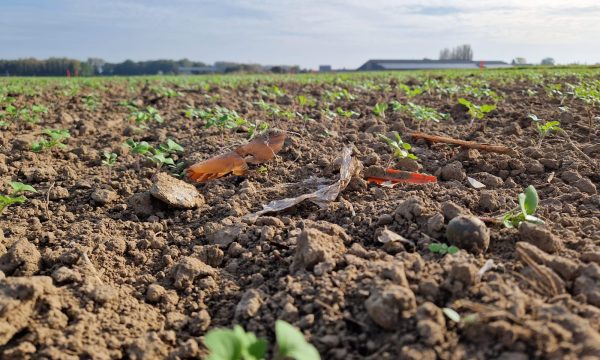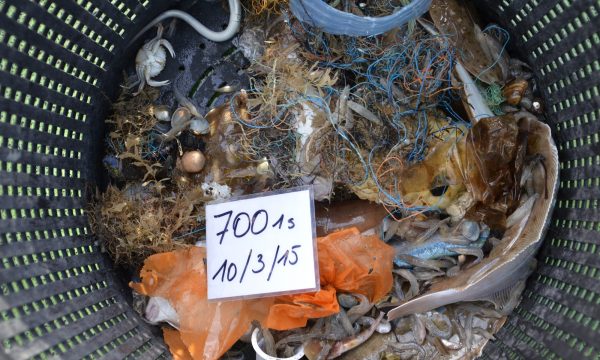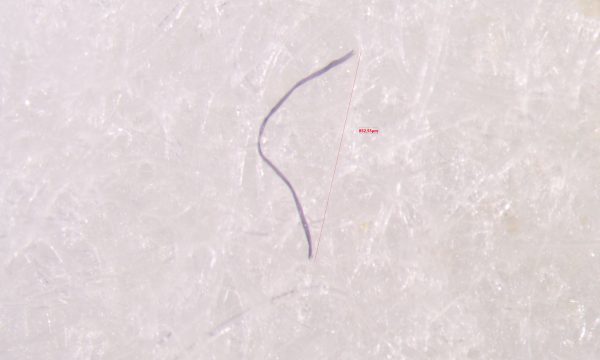Algemeen Kosten en tijd gespaard met nieuwe detectie- en identificatiemethode voor mariene microplastics

Voor haar doctoraatsonderzoek ontwikkelde Nelle Meyers (VLIZ, ILVO, UGent) een nieuwe kosten- en tijdeffectieve methode voor de detectie en identificatie van microplastics in het mariene milieu. De semi-automatische methode combineert het kleuren van microplasticdeeltjes met de fluorescente kleurstof nijlrood en machine-learning algoritmes. De methode testte betrouwbaar voor de meeste types van polymeren, ook als de onderzoekers de microplastics artificieel lieten verweren. Ook voor het analyseren van microplastics in stalen afkomstig uit het mariene milieu was de test succesvol. Met een ondergrens van 4µm is de nieuwe methode ook veelbelovend om in te zetten in blootstellingsstudies, momenteel ontbrekend voor dit groottebereik.
Microplastics – partikels tussen 1µm en 5mm groot – zijn wijdverspreid en persistent in het mariene milieu. Het is dan ook cruciaal om een betrouwbare en liefst ook goedkope methode voorhanden te hebben om microplastic-concentraties te monitoren en hun potentiële risico’s te beoordelen. Er bestaan ondertussen al talloze analysetechnieken voor microplastics. Maar vele daarvan zijn duur, tijdrovend en foutgevoelig, vooral als de microplastics al wat verweerd zijn. De vele analysemethoden – elk met hun eigen resolutie, focus en kwaliteit – maken het overigens moeilijk om verschillende studies te vergelijken. Om deze problemen aan te pakken ontwikkelde Nelle Meyers in het kader van haar promotieonderzoek een innovatieve, betrouwbare methode voor een kosten- en tijdeffectieve analyse van microplastics in het mariene milieu. Ook optimaliseerde ze de protocollen voor de extractie ervan uit zeewater, sediment en biota.

De nieuw ontwikkelde, semiautomatische analysemethode combineert het kleuren van microplasticdeeltjes met een fluorescente kleurstof (Nijlrood) en machine-learning algoritmes. Een eerste algoritme (Beslisboom) helpt beslissen of deeltjes al dan niet uit plastic gemaakt zijn (Plastic Detection Model - PDM). Een tweede algoritme (Random Forest) classificeert de plastic deeltjes verder op basis van hun polymeertype (Polymer Identification Model - PIM).
De prestaties van deze twee modellen werden in eerste instantie gevalideerd voor ongerepte microplastics (50 - 1200 μm). Vervolgens ook voor microplastics die de onderzoekers lieten verweren onder semi-gecontroleerde omstandigheden in oppervlakte- en diepzeewater. De Random Forest-modellen bleken hierbij betrouwbaarder voor de polymeeridentificatie, zelfs voor deeltjes <10µm.
Als derde stap injecteerden de onderzoekers milieurelevante microplastics in mariene biota, waarna ze geëxtraheerd en geanalyseerd werden. De Random Forest-modellen bleken opnieuw heel betrouwbaar voor de detectie en identificatie van zowel ongerepte kunststoffen (nauwkeurigheid >88%) als de meeste verweerde kunststoffen (>70%). Voor partikels tussen 2 en 10µm kon zelfs een nauwkeurigheid van meer dan 90% bekomen worden.
Als laatste testte Nelle de prestaties van beide modellen voor echte zeewater- en sedimentstalen afkomstig uit het Belgische Noordzee. De combinatie van de geoptimaliseerde extractieprotocollen met de modellen, bleken ook hier betrouwbaar, uitgezonderd PET, donkere partikels en microvezels. (De detectie van microplastic-vezeltjes is niet onmogelijk, maar staat momenteel nog niet op punt. De optimalisatie ervan viel buiten het tijdsbestek van dit doctoraat.) De casestudie in de Noordzee resulteerde in de identificatie van het baggerbergingsgebied ‘Loswal Zeebrugge-Oost’ als een echte hotspot voor microplastics.
Tot slot werd een kosteneffectiviteitsanalyse van veelgebruikte analysemethoden voor microplastics in zeewater uitgevoerd, en voorspellende tools ontwikkeld die objectieve informatie bieden aan o.a. onderzoekers en beleidsmakers om een weloverwogen keuze te maken tussen verschillende analysemethoden en hun financiële middelen efficiënt in te zetten voor monitoring en studie.
Nelle verdedigde haar doctoraat op 19 juni op de InnovOcean Campus in Oostende. Promotor van dit doctoraat is Prof. Dr. Colin Janssen (UGent), onder supervisie van Dr. Ir. Bavo De Witte (ILVO) en Dr. Ir. Gert Everaert (VLIZ).
Dit onderzoek werd uitgevoerd als onderdeel van het Andromeda project, gefinancierd door Belgian Federal Science Policy Office (BELSPO). Het experimentele werk werd uitgevoerd in de laboratoria van het Vlaams Instituut voor de Zee (VLIZ) en het Instituut voor Landbouw-, Visserij- en Voedingsonderzoek (ILVO) in Ostende.


